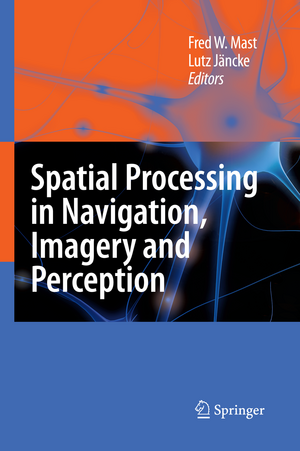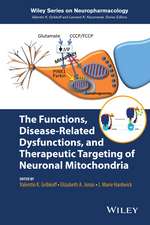Spatial Processing in Navigation, Imagery and Perception
Editat de Fred W. Mast, Lutz Jänckeen Limba Engleză Hardback – 20 iun 2007
| Toate formatele și edițiile | Preț | Express |
|---|---|---|
| Paperback (1) | 952.40 lei 43-57 zile | |
| Springer Us – 3 noi 2010 | 952.40 lei 43-57 zile | |
| Hardback (1) | 960.30 lei 43-57 zile | |
| Springer Us – 20 iun 2007 | 960.30 lei 43-57 zile |
Preț: 960.30 lei
Preț vechi: 1171.10 lei
-18% Nou
Puncte Express: 1440
Preț estimativ în valută:
183.76€ • 192.34$ • 152.94£
183.76€ • 192.34$ • 152.94£
Carte tipărită la comandă
Livrare economică 31 martie-14 aprilie
Preluare comenzi: 021 569.72.76
Specificații
ISBN-13: 9780387719771
ISBN-10: 0387719776
Pagini: 440
Ilustrații: XXII, 442 p. 58 illus.
Dimensiuni: 155 x 235 x 31 mm
Greutate: 0.87 kg
Ediția:2007
Editura: Springer Us
Colecția Springer
Locul publicării:New York, NY, United States
ISBN-10: 0387719776
Pagini: 440
Ilustrații: XXII, 442 p. 58 illus.
Dimensiuni: 155 x 235 x 31 mm
Greutate: 0.87 kg
Ediția:2007
Editura: Springer Us
Colecția Springer
Locul publicării:New York, NY, United States
Public țintă
ResearchDescriere
“Spatial Processing in Navigation, Imagery and Perception” Since the decade of the brain cognitive processes have found their way to the study of brain functions and an increasing number of research studies are dealing with the aspect of spatial processing. In fact, a tremendous part of the cognitive domains studied pertain to spatial processing. However, there is also a growing tendency for diversification in relation to the subprocesses underlying spatial processing. Not only are there studies looking at the well known place cells in rats, rabbits and other animals, there is also an increasing number of studies looking at related topics in humans and monkeys such as spatial orientation, spatial construction, and spatial imagery. These studies, although diverse at first glance, have many aspects in common. We are now on the root to understand the underlying neuroanatomy and neurophysiology much better than ever before. This is made possible by the advent of novel techniques such as structural and functional in vivo anatomy, modeling, and several sophisticated behavioral research tools such as virtual reality techniques and simulators. Spatial processing is fundamental for understanding human cognition. However, compared to other domains such as memory, language, and attention the exploration of spatial functions has been understudied in the past years.
Cuprins
Dedication.- Contributing Authors.- Preface.- Spatial Processing during Mental Imagery: A Neurofunctional Theory.- The Role of Imagery in Navigation: Neuropsychological Evidence.- Functional Equivalence of Spatial Images Produced by Perception and Spatial Language.- Spatial Processing and View-dependent Representations.- Modeling Mental Spatial Knowledge Processing.- Optic Ataxia: A Gateway to the Human Visual Action System.- Interactions between Cognitive Space and Motor Activity.- Cross-modal Involvement of Visual Cortex in Tactile Perception.- Neuroanatomy of the Parietal Cortex.- Spatial Maps, Feature Integration and Parietal Function: Implications from the Study of Spatial Deficits.- Pigs in Space: How We Recognize Rotated Objects.- Functional Neuroanatomy of Mental Rotation Performance.- Spatial Orientation and Navigation in Microgravity.- Spatial Representations in the Rat: Case Study or Perspective on Episodic Memory?- Sensorimotor Transformations in Spatial Orientation Relative to Gravity.- Sensorimotor Control of Human Dynamic Behavior in Space Implemented into a Hominoid Robot.- The Ventro-dorsal Stream: Parieto-premotor Neural Circuits and Their Role in Primate Cognition.- Mind over Matter? Imagined Body Movements and Their Neuronal Correlates.- Bottom-up Effects of Sensory Conflict and Adaptation on Mental Imagery: Sensorimotor Grounds for High Level Cognition?- Cortical Processing of Auditory Space: Pathways and Plasticity.- Networks for Attentional Control and Selection in Spatial Vision.- Acknowledgments.- Index.
Textul de pe ultima copertă
Spatial Processing in Navigation, Imagery and Perception serves as a state-of-the-art platform, on which the very latest developments in spatial processing are presented. Spatial processing is centrally involved in almost any cognitive function and the neural underpinnings of spatial functions are much more complex than they have been conceived before. Studying spatial processing helps to explore how basic cognitive functions operate such as language, attention, perception, movement control and mental imagery. The processing of spatial information is distributed in complex cortical and sub-cortical structures and we are now in a position to better understand the underlying neuroanatomy and neurophysiology. This is made possible by the advent of novel techniques such as structural and functional in vivo anatomy, modeling, and sophisticated behavioral research tools. Modern neuroscientific techniques have been in many ways the catalyst of this research but there is also a revival of behavioral methods used in studies on spatial processing. It is in fact the fruitful combination of both the neuroscientific and behavioral approaches why this exciting field has progressed so far and is still progressing for many years to come.
Research on spatial processing is not only restricted to basic science but rather has important applied implications. It is tremendously important to know how the human brain is accomplishing spatial tasks in real life scenarios such as driving a car, orienting oneself in large scale cities, postural control or playing various sports like baseball, soccer or tennis. Moreover, knowing more about plasticity and training related influences on spatial functions will have a huge impact on how to efficiently insert new technologies in everyday life.
The findings presented in Spatial Processing in Navigation, Imagery and Perception emerge from different disciplines such as cognitive neuroscience, cognitive psychology, neuropsychology, neuroanatomy, computer science and robotics. The reader will learn to see several connections across these disciplines. Chapter authors are the most respected and internationally renowned researchers in the field. This book will be useful for experimental scientists, clinicians and graduate students.
Research on spatial processing is not only restricted to basic science but rather has important applied implications. It is tremendously important to know how the human brain is accomplishing spatial tasks in real life scenarios such as driving a car, orienting oneself in large scale cities, postural control or playing various sports like baseball, soccer or tennis. Moreover, knowing more about plasticity and training related influences on spatial functions will have a huge impact on how to efficiently insert new technologies in everyday life.
The findings presented in Spatial Processing in Navigation, Imagery and Perception emerge from different disciplines such as cognitive neuroscience, cognitive psychology, neuropsychology, neuroanatomy, computer science and robotics. The reader will learn to see several connections across these disciplines. Chapter authors are the most respected and internationally renowned researchers in the field. This book will be useful for experimental scientists, clinicians and graduate students.
Caracteristici
Currently, there is no edited book with a similarly broad scope of different scientific approaches while still focusing on one of the most fundamental abilities, the processing of spatial information
Includes supplementary material: sn.pub/extras
Includes supplementary material: sn.pub/extras













